1. Introduction
 Thermaltake (Tt) is well known in the market and end users for their quality Cooling Solutions and extreme PC cases. Although these products would be enough to please any end user, Tt has taken some steps toward other devices, and has established a very strong market for them as well. Today, we will be reviewing a Tt enclosure product, an external case, that serves as an Interface IDE to USB2.0 medium, where both Hard and Optical drives can be installed and put to use right away.
Thermaltake (Tt) is well known in the market and end users for their quality Cooling Solutions and extreme PC cases. Although these products would be enough to please any end user, Tt has taken some steps toward other devices, and has established a very strong market for them as well. Today, we will be reviewing a Tt enclosure product, an external case, that serves as an Interface IDE to USB2.0 medium, where both Hard and Optical drives can be installed and put to use right away.
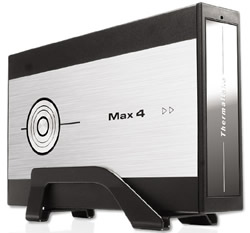
This product comes from the Max4 series, the 5.25 DVD enclosure in specific. Note here, that even though this enclosure is meant for DVD usage (one can install a DVD-ROM, RW device, or even a CD-ROM device, all in the 5.25 scale), the case can also host an internal HDD drive. So, we have an extra function in favor of the end user, who can change and use the enclosure to suit his needs.
Having said that, let us move on to the Specifications and Features of the MAX4 5.25 enclosure.
- Specifications
According to Thermaltake, the Transfer Rate of the MAX4 USB2.0 device is up to 480Mbps.
| Model |
A2296 |
| Case Type |
5.25" DVD
& 3.5" drives |
| Net Weight |
1258g |
| Dimension |
270x175x55mm (H*W*D) |
| Material |
Aluminum & Plastic |
| Interface |
IDE to USB2.0 |
| ATA compatibility |
ATA/ATAPI6 |
| PCBA Chip |
Cypress AT2+ |
| Transfer Rate |
USB2.0: 480Mbps |
| Operating System |
Windows SE, ME, 2000, and XP
Mac OS 9.x and up |
| Accessories |
USB2.0 External cable |
| Power Adapter |
| Metal Foot Stand |
- Features
What follows is a complete list of the features supported by the Max4 5.25 enclosure.
- Application for 5.25" DVD Player
- Aluminum spreader fanless design
- Silver body with graceful black adorn
- Metal homocentric polished diagram
- Blue LED indicate data transfer signal
- Cypress AT2+ chip - speed & protect your digital data
- IDE to USB2.0 interface - the most compatibility
- Compact mount easily to stand
- Transfer speed up to 480Mbps
The Max4 5.25 retail package, includes a power adapter and power supply cable, a USB cable and a CD that contains the installation drivers. The manual comes both in digital form as well as in booklet. Note, that the installation cd under WinXP is not needed, as the device is plug'n'play enabled.
 |
 |
 |
| The components of the Max4 5.25 enclosure... |
Now that we've covered the basics, lets move to the next page and the case itself.
2. Closer Look - Installation
In this page we will take a closer look at Max4 5.25 enclosure while we will describe a little the installation procedure. The Max4 enclosure's dimensions are 270x175x55mm and weighs 1258g, making it easy to use. On top of that, the standing foot provided with the Max4 enclosure, rendering the placement of the external case to either horizontal or vertical pose.
 |
| The Max4 retail package contains a standing foot for vertical or horizontal orientation. |
The front panel comes with a reflect enabled Black Mirror Coating, which comes off when a DVD-ROM is installed to allow the tray to open and close freely.
 |
| Notice the retail package reflected on the front panel coating... |
In the back of the case, we clearly note the power switch, the power input and USB cable input.
 |
| the air holes help in heat dissipation.. |
In order to install any device on to the Max4 we have to firstly remove the back panel. There are two screws that have to be removed.
 |
| we used an electrical screw driver to get the work done... |
Having un-screwed the case, we found the main chipset used by the Max4 mechanism. The PCBA Chip is the Cypress AT2+ model, the same chipset used in the Muse enclosure series and the Max4 2.5 & 3.5 cases.
 |
| the Cypress AT+2 chipset... |
The interface used by the Max4 5.25 enclosure is an IDE to USB2.0, which means that the enclosure is connected via the USB2.0 port in the PC while it uses an 80pin IDE cable to connect the installed device, which can be a CD/DVD drive or even an 3.5" Hard Disk.
 |
| the IDE cable that hooks on the installed device... |
After unscrewing the back panel, we remove the enclosure cover in order to install the desired device.
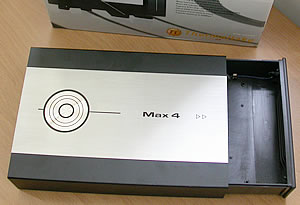 |
| The installation procedure does not differ at any point from the normal IDE device installation.. |
As the Max4 can host both a DVD-ROM device (DVD-RW, CD-ROM etc.) and a HDD drive alike, we put both devices inside for installation procedure and testing purposes. Note that the screwing of the devices in the case, is mandatory in order to secure the stability of the inserted device. For our tests we used a DVD burner from LG, the GSA-4163B model, and a Hard disk drive by Western Digital.
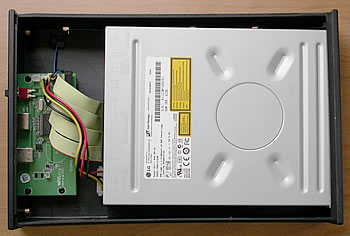 |
| We removed the front mirror coating panel to free the tray... |
Make sure you properly installed the IDE and the power cables onto the device, the drive or the HD, as below.
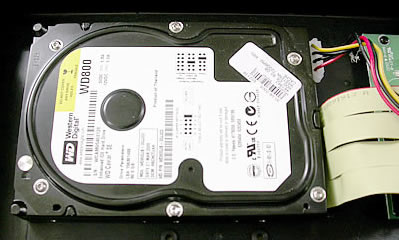 |
| Same procedure as with the drive... |
Normally every DVD drive has screw holes at its bottom. In order to place the drive onto the Max4 there are four screws we have to take care of. The green marks in the following screenshots indicate where the DVD drive should be placed on.
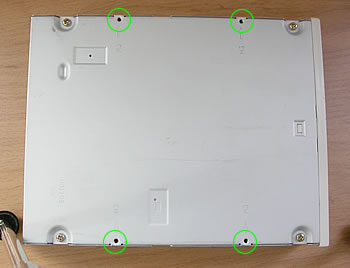
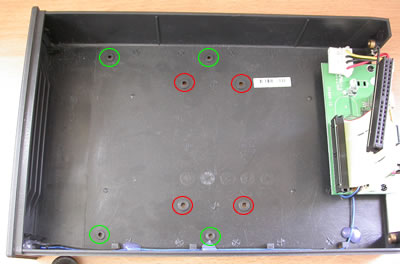 |
| Red marks indicate the mounting points of the HDD drive while the green marks indicate the mounting points for the DVD-RW drive. |
Much like the DVD drive, the HDD device is screwed on the bottom panel. The red marks indicates the screw points...
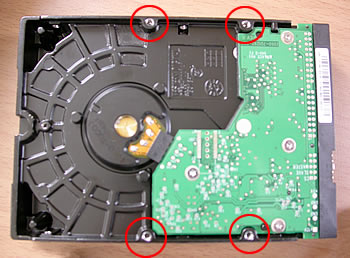
Last step was to screw the device on the bottom plate and put the cover back on the enclosure and the procedure was completed.
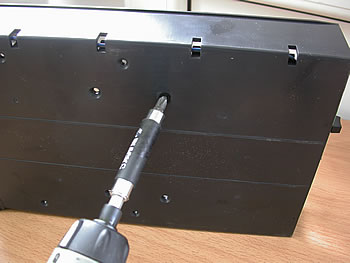
The Max4 5.25'' enclosure was ready to be put to testing. For testing the potentials of the Tt enclosure we used two benchmarks; the SiSoftware Sandra and the Passmark Performance Test.

Now lets move to the next page of this review and to the testing of the Max4 with both an HDD and DVD-RW devices.

3. Performance
 Passmark Performance Test is an award winning PC hardware benchmark utility that allows everybody to quickly assess the performance of their computer and compare it to a number of standard 'baseline' computer systems. Twenty seven standard benchmark tests are available in seven test suites plus there are five advanced testing windows for custom benchmarking. CPU Tests, 2D Graphics Tests, 3D Graphics Tests, Disk Tests, Memory Tests and CD/DVD Tests. In our case we selected the Disk suite Tests.
Passmark Performance Test is an award winning PC hardware benchmark utility that allows everybody to quickly assess the performance of their computer and compare it to a number of standard 'baseline' computer systems. Twenty seven standard benchmark tests are available in seven test suites plus there are five advanced testing windows for custom benchmarking. CPU Tests, 2D Graphics Tests, 3D Graphics Tests, Disk Tests, Memory Tests and CD/DVD Tests. In our case we selected the Disk suite Tests.
Passmark Disk Test
This suite contains a number of tests that exercise the mass storage units (hard disk or otherwise) connected to the computer. By default drive C: is used but this can be changed from the Preferences Dialog.
For each test a file is created in the root directory of the selected disk. The file size needs to be large in order to get an accurate measurement. In the case where a slow drive is used on a computer with a large amount of RAM this test can take some minutes to complete.
There are a few issues to aware of when interpreting the results of the disk test. These are covered in the precautions section.
- Disk Sequential Cached Read
A large test file is created on the disk under test. The size of this test file is proportional to the amount of RAM available, which stops the entire file from being cached in RAM. The file is read sequentially from start to end. The amount of data read in each individual read operation is always 16KB
- Disk Sequential Cached Write
A large file is written to the disk under test. The size of this test file is proportional to the amount of RAM available. This stops the entire file being cached in RAM. The file is written sequentially from start to end. The amount of data written in each individual operation is always 16KB
- Disk Random cached Seek RW
A large test file is created on the disk under test. The size of this test file is proportional to the amount of RAM available, this stops the entire file being cached in RAM. The file is read randomly; a seek is performed to move the file pointer to a random position in the file, a 16KB block is read or written then another seek is performed. The amount of data actually transferred is highly dependent on the disk seek time.
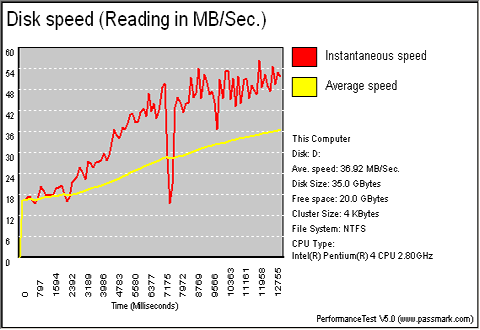 |
| HDD on IDE |
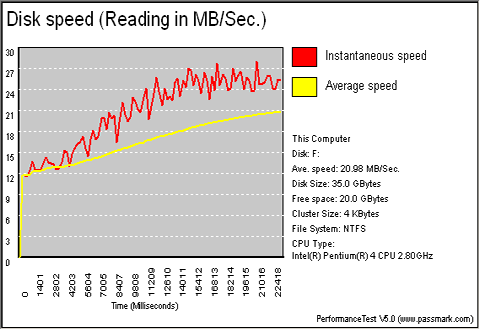 |
| HDD on Max4 |
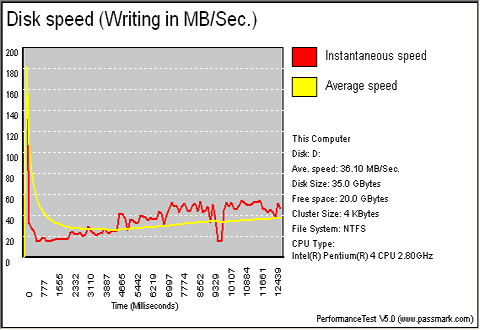 |
| HDD on IDE |
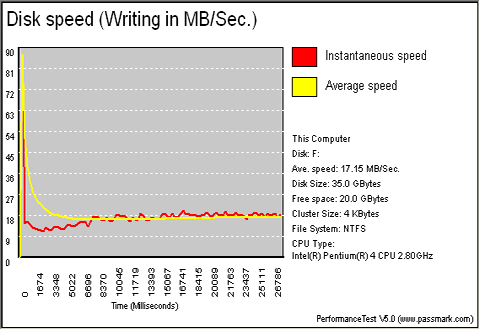 |
| HDD on Max 4 |
Almost double performance when the HD is connected on the motherboard.
Unlike the HD, the drive reported almost the same performance either connected to the motherboard or as an external in the Ma4 enclosure.
 SiSoftware Sandra is a 32 and 64-bit Windows system analyzer that includes benchmarking, testing and listing modules. It tries to go beyond other utilities to show you more of what is really going on under the hood so you draw comparisons at both a high and low-level in a single product.
SiSoftware Sandra is a 32 and 64-bit Windows system analyzer that includes benchmarking, testing and listing modules. It tries to go beyond other utilities to show you more of what is really going on under the hood so you draw comparisons at both a high and low-level in a single product.
You can get information about the CPU, chipset, video adapter, ports, printers, sound card, memory, network, Windows internals, AGP, ODBC Connections, USB2, Firewire etc. You can save/print/fax/e-mail/post/upload or insert into ADO/ODBC databases reports in text, HTML, XML, SMS/DMI or RPT format.
This version supports multiple sources of information gathering including: remote computers, PDAs, Smart Phones, ADO/ODBC databases or saved system reports. All benchmarks are optimized for both SMP & SMT (Hyper-Threading), up to 32/64 CPUs depending on the platform.
File system Benchmark
- The "File system" which tests how your drive(s) and controller(s) compare to other devices in a typical system:
· Read Test: Buffered, Random, Sequential
· Write Test: Buffered, Random, Sequential
· Seek Test
The "Drive Index" mark is a composite figure representing an overall performance rating based on the average of the read, write, and seek tests, and file and cache size. The Drive Index is intended to represent drive performance under typical use in a PC. A larger number means better performance. The weighting of the results is not equal and represents the distribution of different files sizes as used on these devices (obtained through field research).
| File system Benchmark |
| HDD on IDE |
 |
| HDD on Max4 |
 |
The HDD device performed better connected on the motherboard, with almost double the performance to the same HDD on the Max4 enclosure.
Removable Storage/Flash Benchmark
- The "Compact Flash" typical usage model for these devices is File operations, such as Writing a file to the device, reading a file from it, and deleting a file. This benchmark exercises the devices in terms of these operations (to measure the “raw” cluster level performance of the device, it is recommended to also test it by means of the File System Benchmark module). The following characteristics are measured for each of the four representative file sizes of 512 Bytes (representing a minimal single data cluster file), 32kB, 256kB and 2MB. The weighting of the results is not equal and it represents the distribution of different files sizes as used on these devices (obtained through field research). For each of the four file sizes, a Combined Index is then calculated, stating the combined performance in terms of Combined Operations Per Second, with respect to a mix of write, read and delete operations.
- Combined Device Index: is a composite figure representing an overall performance rating based on the average of the Combined Index figures over the four file sizes. (Higher is better, i.e. better performance)
- Endurance Factor: is a figure representing the Wear and Life Expectancy of flash devices; this is obtained by dividing the average performance (normal condition, i.e. sequential write) to the lowest performance (high-stress condition, i.e. same block re-write). It measures the relative improvement of endurance caused by the wear leveling or flash management algorithm; the absolute endurance of a device (i.e. its expected life-time) is directly dependent, in addition to this Endurance Factor, on the nominal manufacturer rating of maximum erase/reprogram cycles, which is typically 100,000+ for SLC and 10,000+ for MLC devices. (Higher is better, i.e. longer life-time for the device)
| Removable Storage/Flash Benchmark |
| HDD on IDE |
 |
 |
| HDD on Max4 |
 |
 |
Once more, as expected, the HDD on M/B IDE performed better than the Max4 enclosure. Note also, that the Endurance factor for the HDD when put normally under the standard IDE interface is increased in comparison to the Max4 endurance factor.
CD-ROM/DVD Benchmark
Tests how your CD-ROM/DVD drive and controller compares to other CD-ROM/DVD drives in a typical system:
- Read Test: Buffered, Random, Sequential
- Seek Test
This benchmark consists of 2 different tests:
- Data CD performance
- DVD performance
For these tests, the Sandra Test CD/DVD disks are recommended that contain the optimum data files. You can also make a compatible test CD/DVD by burning one with a file of 1/3 disk capacity in the root and similar size files that fill the CD.
CD/DVD Drive Index: is a composite figure representing an overall performance rating based on the average of the read, write, and seek tests, and file and cache size. The CD/DVD Drive Index is intended to represent drive performance under typical use in a PC. A larger number means better performance. The weighting of the results is not equal it represents the distribution of different files sizes as used on these devices (obtained through field research).
| CD-ROM/DVD Benchmark |
| DVD on IDE |
 |
| DVD on Max4 |
 |
The DVD performance in both cases reported equal results, with a drive index of 5MB/s for both the IDE and Max4 interfaces.
The final test we did was a simple transfer rate reading test with Nero's CDSpeed.
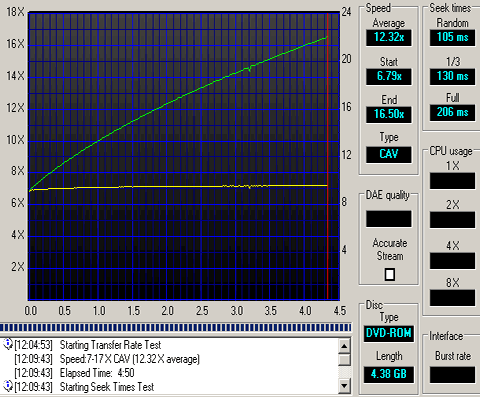
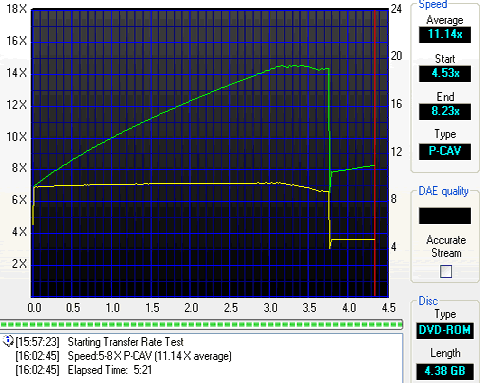
The reading started at the same speed there were differences at the end when using the Max4. When the drive was connected on the motherboard the reading graph was smooth with any single speed drop. In case of Max4 and USB2.0 interface it seems that the drive failed to reach its maximum reading speed of 16X. Over 14X the drive lower its speed down to 8X. When it comes in reading this is not a great issue but in case of recording might the process might fail. We used the "Create Data Disc" feature of CDSpeed and fortunately we didn't notice any speed drop, apart from those of the drive's writing strategy.

4. Conclusion
The need for constant backups and versatility has pushed the manufacturers in creating backup solutions in the form of external devices and USB sticks. But the largest part in the back up scene, is taken by the external enclosures, used to host HDD drives as well as DVD-RW-ROM drives. The Max4 5.25 is an external DVD-ROM enclosure, an IDE to USB2.0 interfaced case, that can host both CD/DVD devices, as well as HDD IDE drives. Notice that not all enclosures can host HDD devices.

The Max4 5.25 of the Max4 enclosure cases series, is a fancy, polished designed case, that weights about 1600g and it can be described as rather big enclosure, due to its potential to host a 5.25 drive. Its performance as we've seen from the tests in the previous pages, is good mostly with CD/DVD devices. However we didn't like the fact that the drive failed to reach its maximum reading speed of 16X. In case of HDD there is a great difference as it was expected but even in that case performance is good.
At the time of this review the price of the Max4 was $34.
